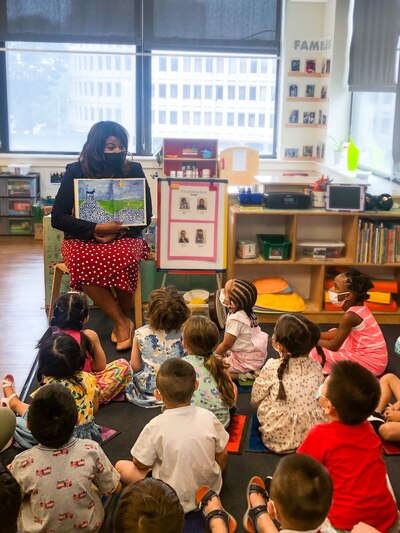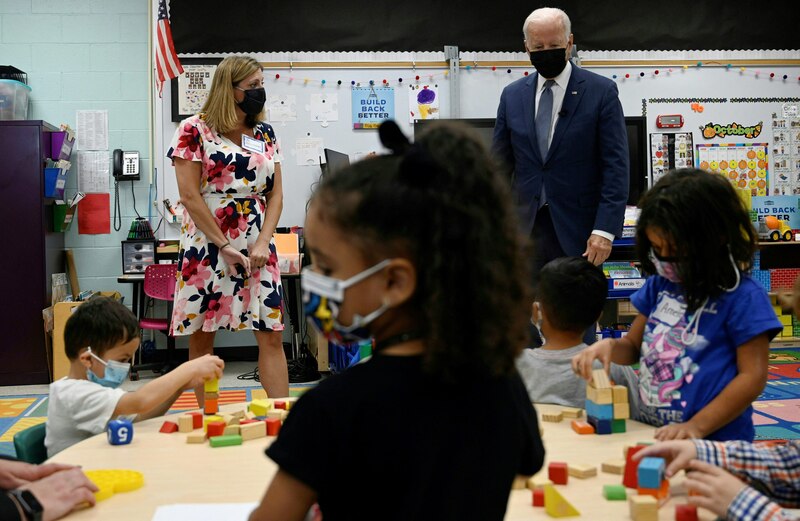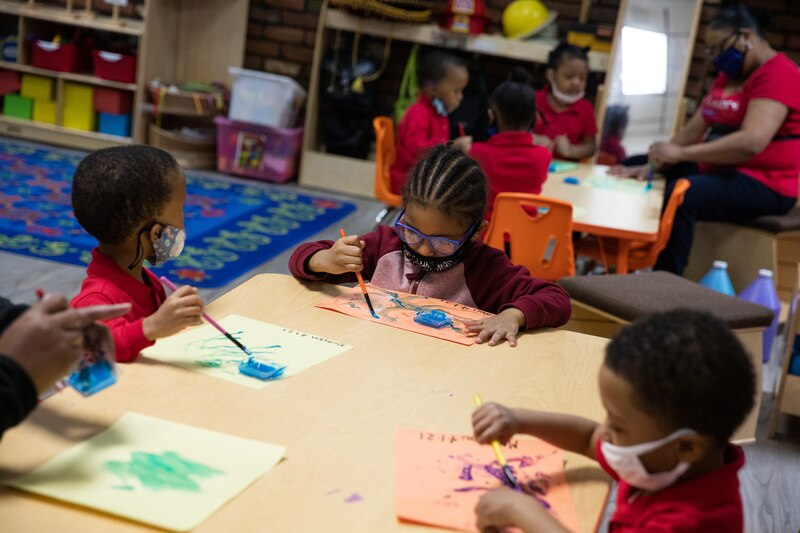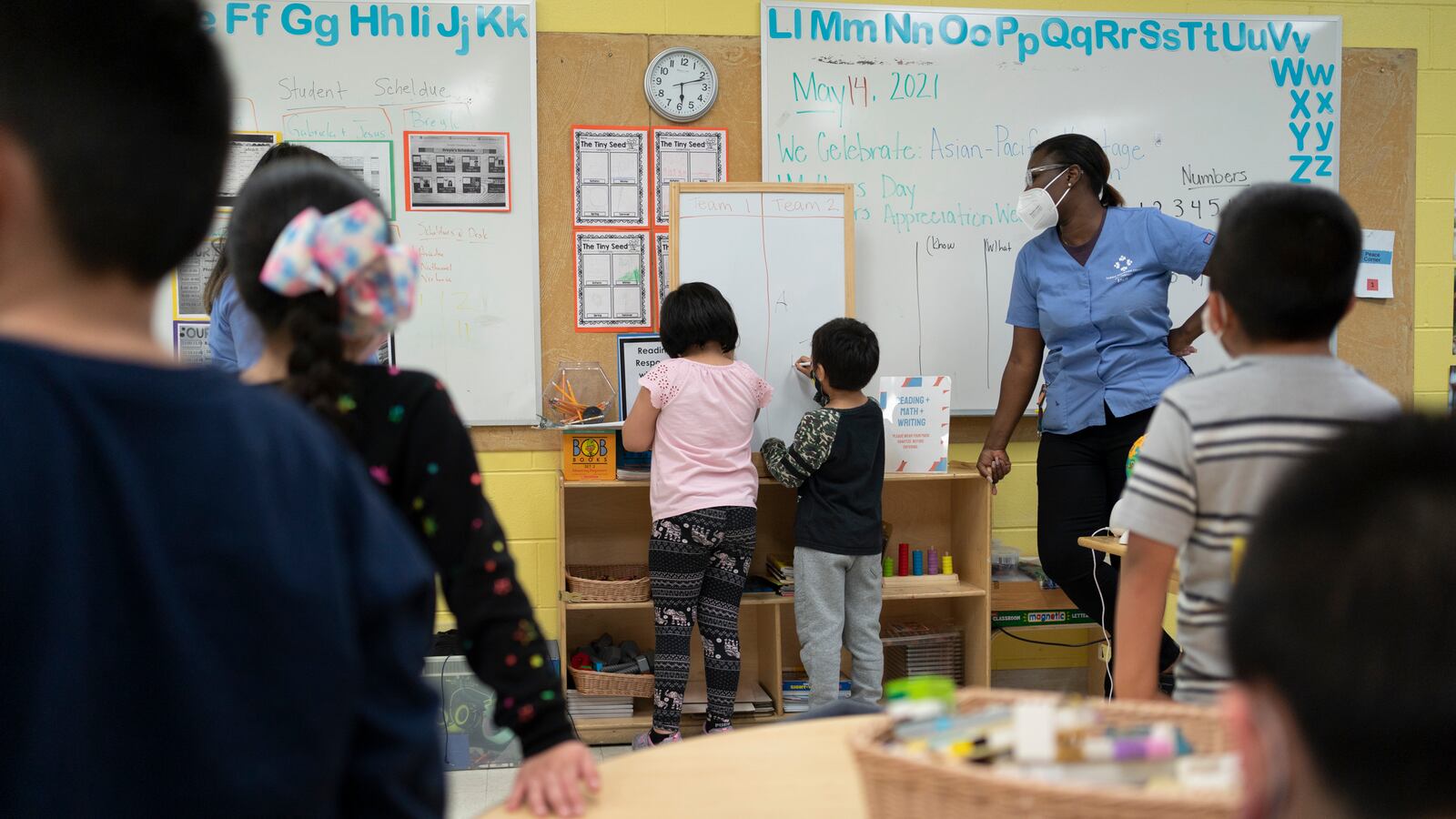In her 45 years running Children’s Village Child Care center in the Chinatown section of Philadelphia, Mary Graham has seen hundreds of staff members come and go.
When Jha’Nyse Lundy-Reid showed up one day, Graham knew she was a keeper.
Lundy-Reid is an artist, working in charcoal, ceramics, glass blowing, and creating coloring books for children. But talented as she is, her art didn’t provide a living. “It wasn’t working,” Lundy-Reid said. “I needed something to supplement my income.”
Her sister, who worked as a substitute teacher at Children’s Village, told her that the center was always looking for new staff. Lundy-Reid started working there part time in October 2018. “I loved it,” she said. “I found that I loved working with children.” She became a full-time staffer in August 2020.
Identifying individuals like Lundy-Reid who may have been overlooked for child care jobs in the past is one of several ways that Philadelphia providers are trying to solve unprecedented staffing shortages.
While staffing has always been an issue in the industry due to its persistently low pay and often stressful working conditions, shortages have never been as bad as they are now. During the pandemic, 255 of just over 1,000 total centers in the state permanently closed.
The state helped providers continue to pay staff for several months in 2020, but that didn’t last long. Many workers found that they could make more money working at Target or Walmart or Starbucks, among the companies that have raised wages in an effort to maintain their own staffing levels.

Providers are doing what they can to search for solutions. Graham and others, with anticipated money from one of the federal relief packages, raised wages and benefits and offered signing bonuses in an effort to recruit and keep workers so they could simply stay afloat. They are identifying new types of employees, including artists like Lundy-Reid and others in creative pursuits who need to supplement their incomes. They are also looking seriously at hiring family members of the children they serve and focusing on career growth.
To bring these new staff members in, providers are relaxing some educational requirements for aides and other support workers in the centers.
But those who run child care centers and preschools say these efforts aren’t enough — that state, federal, and city leaders need to treat the issue with more focused urgency. Pennsylvania received $1.2 billion in American Rescue Plan funds with $720 million earmarked to go directly to centers. The law was passed last spring, but that money was only recently distributed.
“That money started to flow in September, and that’s a good thing,” said Carol Austin, executive director of First Up, an early childhood education advocacy group. “But everybody knows it’s short term. It’s not really sensible to use it to increase salaries, because we can’t sustain that after the money’s gone.”
For her, the long-term answer is to pass President Biden’s Build Back Better plan, now being negotiated in Congress, which would devote $400 billion to extend pre-kindergarten to an estimated 20 million 3- and 4-year-olds. So far, as lawmakers and the administration try to craft a bill that can get all 50 Democratic votes, that proposal has remained intact and hasn’t been recommended for the chopping block.
“That would be a game changer,” Austin said, permanently providing funds to underwrite higher salaries and supporting educational requirements for teachers. Most importantly, the plan would recognize the importance of child care and preschool availability to the nation’s economy.

In the meantime, however, child care providers in Philadelphia and elsewhere in the state continue to struggle with day-to-day issues.
Due to a shortage of workers exacerbated by the pandemic, programs “have closed classrooms, they have turned away families, they have long waiting lists,” said Mai Miksic, the early childhood policy director for Children First, formerly Public Citizens for Children and Youth. “Not just teachers, but directors are leaving.”
First Up, a child care advocacy organization in the five southeast Pennsylvania counties, organized a “Day of Hire” last month that yielded about 100 new applicants.
Before the event, Children First sponsored job fairs. At one in Germantown, four or five providers came to recruit, “and we got maybe three people interested,” Miksic said.
“It’s a hard job,” Miksic said. “Children are a lot of work, you have to have a big heart, a lot of empathy, a lot of patience. It’s a lot easier to hand out a cup of coffee.”
Damaris Rodriguez-Alvarez is the executive director of Children’s Playhouse, which has two sites in South Philadelphia neighborhoods that have large immigrant and refugee populations.
“Staffing since the pandemic has been horrendous,” she said.
On the Day of Hire, three people applied for jobs, and two were hired, she said, including a family member of one of the children. “This made me think, I need to do things differently,” Rodriguez-Alvarez said. “I’m trying to build on that. I hired a couple of family members to support teachers in the classroom.” She is also talking to the city and the school district to help with a wider initiative in this area, relaxing requirements so that centers can hire family members with high school diplomas.
But this still requires additional funding to underwrite higher wages, she said, and to help those workers obtain the child development associate, or CDA, credential needed for workers if a center is to get a high-quality rating from the state.
Now, the situation is impossible, she said. Pre-pandemic, Children’s Playhouse had 288 children in three major programs: PHLPre-K, Head Start, and PreK Counts. Now, she has 158 because she doesn’t have enough staff.
“These assistant teachers are hard to find right now,” she said. She posed the question: Why would anyone work in child care for $14.50 an hour — exposing themselves to unvaccinated children and dealing with all the stresses of the job — when they could make $21 an hour at Amazon?

Even with a labor shortage, Philadelphia is still working to expand its early childhood programs.
The city’s Office of Children and Families this year added 700 new PHLPre-K slots, for a total of 4,000, and added 27 providers to the program. And it has just established the SPARK Quality Support Center to work with providers to address a range of needs, including staff recruitment, professional development, and shoring up business plans. The city is partnering with Shine Early Learning, an organization that works nationally with child care programs to improve their quality.
The SPARK center “represents a new vision of supporting providers,” said Sean Perkins, the city’s chief of early childhood education. The city has hired Traci Childress, who ran St. Mary’s Child Care Center in West Philadelphia for years, to operate the center. Kate Eisenpress is the city’s new Director of Early Childhood Strategic Initiatives.
In terms of helping with the staffing shortage, Eisenpress said, “This is a good start, not the end.”
At Children’s Village, Graham has maintained the size of her 20-person staff by focusing on career growth. She makes good use of the state’s Teacher Education and Compensation Helps Early Childhood, or TEACH, program.
Lundy-Reid was a step ahead because she already had some college education, earning an associate degree in art. She is now studying for her child development credential through TEACH, a public-private partnership including businesses, foundations and government that offers scholarships to help child care workers improve their education and their compensation. Through TEACH, the college courses are free, and she gets paid release time during the work day to attend them. It is a powerful incentive.
“The minute I get 18 ECE credits, I get another raise,” Lundy-Reid said.
Graham also said that the city, state and federal governments need to do more to keep the child care industry viable. The industry is built largely on the backs of women, she said, “and the problem is people are living paycheck to paycheck. Child care directors and employees don’t have pensions.” More long-term thinking is necessary, she said, and she is hopeful that the pandemic proves to be the reckoning point.
As for her own center, “We’ve been here for 45 years,” Graham said. “We’ll survive.”


